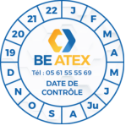
Gas detection to save lives at sea!
SOLAS is the acronym for "Safety Of Life At Sea" or in French: "Sauvegarde de la vie humaine en mer". It is the most important treaty concerning the safety and security of merchant ships. It applies to passenger ships and also to cargo ships of 500 gross tonnage or more.
In this article we will define more precisely the amendment of January 1, 2015 and July 1, 2016 to make mandatory pre-entry and rescue measures in enclosed spaces on ships.
1/ A little history ...

The purpose of the SOLAS Convention is to specify a number of standard and minimum standards to ensure the safety and security of merchant and passenger ships. Its respect proves that the ship is up to standard and can sail on international waters.
This convention was born after a tragic event known to all: the sinking of the Titanic in 1912. It brings together thirteen countries including the United Kingdom to define a number of requirements for the safety of ships: watertight and fire-resistant bulkheads, fire-fighting and rescue equipment, etc. Unfortunately, the project could not be ratified because of the outbreak of World War I.
Thereafter, many conventions took place but it is the fifth and last edition composed of 71 countries in 1974 that was adopted by the International Maritime Consultative Organization now called IMO or International Maritime Organization.
2/ The amendment of January 1, 2015

Confined Space Entry and Rescue Drills:
"An amendment to SOLAS Regulation III/19, on emergency training and drills, makes it mandatory to conduct confined-space entry and rescue drills, which will require crew members with confined-space entry rescue responsibilities or to participate in a confined-space entry and rescue drill at least once every two months."
This rule was introduced because of the large number of fatal accidents that occur in storage rooms or other confined spaces.
For example, when crew members go to do maintenance or cleaning in the holds. They may suffocate and lose consciousness as a result of the rotting or ripening process of the goods stored there.
Our first instinct would be to enter this space as quickly as possible to help the person in danger. By doing so, we also become a person in danger.
That is why the SOLAS amendment of January 1, 2015 states that all persons authorized to work in a confined space and the safety officer must undergo appropriate training once every two months because there are rules that define the proper procedure for entering a confined space.

What is a "closed" space?
Also known as a "confined" space, it is a space with restricted entrances and exits, but large enough to allow access to a person for maintenance, cleaning or repair.
Because of the narrowness of the openings, the air renewal in these spaces is reduced, hence the need to verify that there are no risks of asphyxiation, flammability and toxicity of the air before entering.
The identification of these spaces is done beforehand by a risk analysis made by the person in charge of the vessel. They must be secured in order to prohibit access to unauthorized persons and to warn them of the potential danger.
3/ The July 1, 2016 amendment
Article 221-XI-1/07: Instrument for checking the atmosphere of enclosed spaces
"Every vessel to which Chapter I applies shall carry one or more portable instruments that are capable of checking the atmosphere. As a minimum, these instruments shall be capable of measuring the concentrations of oxygen, flammable gases or vapors, hydrogen sulfide and carbon monoxide prior to entry into confined spaces. The carriage of instruments under other requirements may satisfy this rule. Appropriate means shall be provided for the calibration of all such instruments."
Some examples of confined spaces on a ship are fuel tanks, ballast tanks, hulls, ship holds ... They present significant or even fatal dangers to the crew.
That is why the amendment requires:
- "One or more portable instruments that allow the atmosphere to be checked". These are portable gas detectors to verify that the atmosphere of the confined space in question is safe and breathable for the crew, to be used prior to entering the space defined as enclosed or hazardous.
- "These instruments must be capable of measuring the concentrations of oxygen, flammable gases or vapors, hydrogen sulfide, and carbon monoxide" to prevent the presence of toxic gas, the risk of explosion, or simply the lack of oxygen (asphyxiation).
- Appropriate means must be provided for the calibration of all these instruments. This means that each vessel must be equipped with a calibration station for portable gas detectors to ensure that the devices are properly calibrated and self-sufficient in the open sea.
However, having measuring and calibration instruments is not enough, it is necessary to ensure that the personnel designated by the ship's safety officer to intervene in these confined spaces are trained in the use of the portable gas detector as well as in the use of the calibration station.


The amendment tells us that we should get a portable, multi-gas detector (O₂, H₂S, CO, Explo). However, the choice of a portable gas detector should be guided by a few other essential features to withstand harsh conditions!
- It is must be robust and reliable in the most extreme conditions. So it must resist blows, foreign bodies or water regardless of the temperature, pressure or humidity at sea.
- It must be explosion-proof so that it does not become a source of ignition in areas with explosive atmospheres.
- It must be electromagnetically compatible so as not to be disturbed by the use of electronic equipment in the vicinity.
- It must be associated with a manual or automatic pump (because a measurement is made before entry).
- The detector must have the MED (marine equipment directive) conformity mark.

The MED confirms that a product or piece of equipment is approved for use on board ships of EU member states and ships belonging to countries that have agreed to apply the Marine Equipment Directive 2014/90/EU. This mark is sometimes referred to as the "wheelie bar" and also M.E.D/MED approval or certification. It confirms that the equipment or product is suitable for use in the marine sector.
All approved and licensed products are registered in the MarED database which contains information on over 35,000 licensed devices. Products are tested by an independent third party, such as Germanischer Lloyd, for use in the marine environment before receiving a certificate of approval.
NB: This gas detector must be equipped with a calibration station so that the crew can be fully self-sufficient in calibrating the devices, and upgrading on the high seas.

This gas detector must be equipped with a calibration station so that the crew can be completely autonomous for the calibration of the devices, and the upgrading on the high sea.
Example of the composition of a typical calibration set :
- an automatic or manual calibration station
- standard gas
- a regulator
- spare parts
- ...










